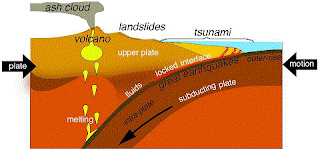 |
| subduction zone graphic |
As was typical of HubPages (and Squidoo) contributors, Gutierrez pounded out a humongous pile of words, well in excess of 2,000 if our count is correct. Since the self-described renaissance man did little more than download information and reword it, at least some of what he wrote (and we use that word loosely) is correct or "correct-adjacent." Not all of it, however, is factual. We don't like that, because an unknowing middle-schooler who draws on this for "research" won't know which parts to ignore. We do, however, and here's a (partial) list of suspect statements:
- "A volcano is a geological rupture in the earth's crust triggered by pressure, temperature, and other natural forces in the planet's interior." – Really? our geologists think they're a result of buoyancy. Didn't mention that, didja, José.
- "A volcano forms when pressure, temperature, and other natural forces push magma out of a magma chamber..." – See "buoyancy" above. You see, José, hot liquid magma is less dense than the surrounding solid rock and, like a helium-filled balloon, will rise.
- "The formation of volcanoes has contributed to the configuration of many of the planet's varied landscapes." – Not really.
- "Tectonic plates resemble puzzle pieces and are constantly moving toward, against, and alongside one another. " – You forgot "away from," a significant omission.
- "90% [of active volcanoes] lie in the "Ring of Fire," which is a perimeter of oceanic volcanoes that circle the Pacific Ocean. These active volcanoes were formed by the subduction of oceanic plates under continental plates." – Not all of them, d00d: a great many are the result of ocean-ocean subduction where the Pacific and the Indian Ocean plates collide. Most volcanoes, in fact, are on oceanic collision zones.
- "In a subduction zone, an oceanic plate submerges into the mantle under a continental plate. The friction created by the plates' movement creates magma" – No way, José! The descent of oceanic crust into the much hotter mantle causes melting, not "friction"!
- "Areas where volcanoes that form on land away from tectonic plate boundaries are known as hotspots. These volcanoes are formed when hot magma rises through intrusions in the crust known as mantle plumes." – That's not what a mantle plume is, dumbass!
- "More than 95% of the Earth’s first 16 km (10 miles) of crust is made of igneous rock (basalt) formed by lava eruptions."– No, José being igneous does not mean either basalt or "formed by lava eruptions"!
At this point, we were about halfway through the post. Gutierrez, of course, had lots more to say, much of it equally bogus (we omitted a lot of what he'd already said by this point). We did, however, want to close with this claim:
"[Volcanoes] are formed due to the activity of the earth´s lithosphere by plate tectonics. The natural activity of the planet, such as tidal changes, earth´s rotation, gravitational pull cause tectonic plates to shift and collide. This movement of tectonic plates underwater causes underwater volcanoes to form where two tectonic plates meet, most commonly at convergent and divergent boundaries."
José clearly fails to understand the driving forces behind plate tectonics. We have to ask ourselves why someone so ignorant would pound out so much misinformation (as well as why HubPages lets this bullshit stand)? The answer is simple: greed. Our Dumbass of the Day wanted more pennies; and HubPages has never given a rat's ass whether what they publish is accurate, as long as they can plaster it with ads – mostly clickbait. So there.
SI - VOLCANOES
No comments:
Post a Comment